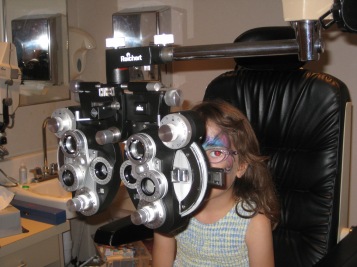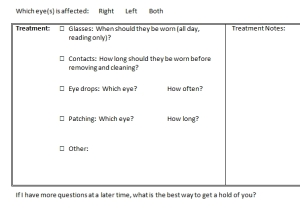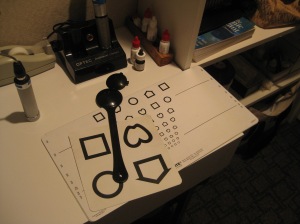Maybe your child failed a vision screening at the pediatrician’s visit and you were given a referral, or maybe you’ve noticed that there seems to be something off about the way he looks at things, or maybe her teacher mentioned that she crosses her eyes, or maybe you’re being proactive and making sure his vision is checked early. Whatever the reason, now that you have an appointment with an eye doctor scheduled, you’re wondering what that eye exam is going to be like and wondering how to prepare.
I’ve been to many, many eye exams with Zoe in the past 5 1/2 years. I think every exam, I’ve forgotten to prepare in some way or another. So this is a compilation of all the things that I’ve wanted to remember. Not all of these tips will be relevant for your child, depending on your child’s age and temperament and how he responds to doctors.
Eye exams for kids are not quite the same as they are for us, though there are definitely similarities. The aim of the exam is to find out how healthy your child’s eyes are, how clearly your child is seeing, how well her eyes are moving, and how well her eyes work together. The eye doctor will also look into your child’s eyes to make sure the structures of the eye are healthy, and to see the shape of their eye.
Note: This does not address the special case of exams under anesthesia (EUAs), which are exactly what they sound like: eye exams that are done while your child is under anesthesia. These are done only in very specific cases where needed for certain diagnoses. You can read more about EAUs here.
Scheduling the appointment
Most pediatric eye exams will take at least an hour, and part of that will be waiting while dilating drops take effect. Ask the office how long the appointment will be, and try to schedule the appointment around your child’s naptime.
Things to bring
- Diapers (if needed)
- Toys to play with while waiting for the appointment, and waiting for the drops to take effect.
- Snacks – especially if the exam is scheduled over a time when your child is likely to be hungry
- Sunglasses if your child’s eyes will be dilated. (I always forget the sunglasses!)
- List of medicines that your child is currently taking
- Medical history for your child, and any family history of vision problems
- List of questions that you have for the doctor
- Note pad to write down information you get from the doctor.
For those last four items, I put together an eye exam notes page that you can download and print. It has space for you to record some information before the exam, and space to write notes during the exam.
Things to know about the eye exam
- A good pediatric eye doctor really will be able to get a good idea of your child’s vision. They will have a variety of eye charts and tests to determine your child’s vision, regardless of their age or verbal abilities.
- You will be doing some waiting, especially if your child’s eyes will be dilated, which is likely, especially if this is your first exam.
- Even though most of the exam does not hurt, a lot of kids respond nervously, especially when the doctor is looking in their eyes.
- Dilating eye drops sting, but it’s temporary.
Preparing your child
Obviously, it depends on your child’s age, how much they’ll understand about going for an eye exam, but if they’re old enough, it’s a good idea to talk about the eye exam at least a day or two before you go in and to introduce them to some of the things that will happen at the exam. You can reassure them that there will be no shots. Mostly, the exam will be like playing games: watching toys and naming shapes.
If your child is verbal, you might practice drawing different shapes or letters on a piece of paper or chalk board and have your child name them when you point to them (it doesn’t matter what shapes you use, you just want to get them used to the ideas of naming the different shapes). But keep it light, and let your child know that the doctor will be trying to figure out if there are ways to help them see better. The eye charts are not testing how smart your child is, they’re checking to see how clearly they can see. This was a huge deal for my daughter after she started kindergarten. Even though she had been to many eye exams by that point, she still started getting worried about getting the “right” answer rather than letting us know what she could and couldn’t see. Prevent Blindness America also has a practice eye chart for kids aged 3-5 who can identify the letters H, O, T, and V.
You may also want to practice eye drops and looking in your child’s eye, two other events that will happen at the exam. Your child will likely have drops to dilate their eyes, it helps the eye doctor get a better view inside the eye, and see the shape of the eye. But very few kids like getting the drops. If you have a small bottle, you can pretend to put drops in a stuffed animal or doll’s eye and then in your child’s eye. Have them tip their head back, close their eyes, say “drop!” and then have them blink. Then you might use a magnifying glass to look closely in your child’s eyes.
Taking Notes
The eye exam notes sheet mentioned above has some common questions you might want to ask the doctor at the exam, and space to record your own questions and notes about your child’s vision and the treatment plan, if there is one. Wehn possible, having a second adult at the exam is very helpful. Zoe was often completely worn out by the end of the exam and throwing a fit. So one of us would be handling her, and the other could pay attention to what the doctor said. Even with that, we always found ourselves with a few questions that we forgot to ask or thought of later. You should always be able to contact your doctor and ask those questions.




Thanks for the tips! I’m taking my child to the eye doctor for her first eye exam, so it helps to know about what I need to do to help prepare her for it. I thought that your tip to bring sunglasses to the eye doctor if my child’s eyes will be dilated. That seems like really good advice. I’m pretty sure that the eye doctor will dilate my daughter’s eyes, so I’ll be sure to bring the sunglasses.
LikeLike
Just preparing your children for the eye exam will help them to not be so nervous. As long as they know what the test is for, they shouldn’t have a problem either. Another good tip would be not to touch your eye when you have to cover it. It makes everything blurry for a while sometimes and that can make your vision seem like it is off.
LikeLike
Pingback: when you’ve just found out your young child needs glasses | Little Four Eyes·
great tip about practicing the eye drops. we will also review our HOTV letters 🙂
LikeLike
I appreciate the tips on preparing your child for their first eye exam. I agree that it is important to find an eye doctor that has experience and knows what they are doing and how to really get you or your child the right prescription. My sister is taking her daughter in soon to get an eye exam, I will be sure to share these tips with her.
LikeLike
My son has been having some trouble seeing and I thought it would be best to get him an eye exam. I would love to be able to prepare him for the exam. That is a good idea to practice some of the things that the eye doctor might do so that they will be comfortable when they go. I didn’t think about that! Thanks for the tips!
LikeLike
My doctor thinks my daughter might be having a hard time seeing, so I’m taking her to an eye exam soon. It was helpful when you said to take a list of meds your child is taking. That way the eye doctor can know any important information needed.
LikeLike